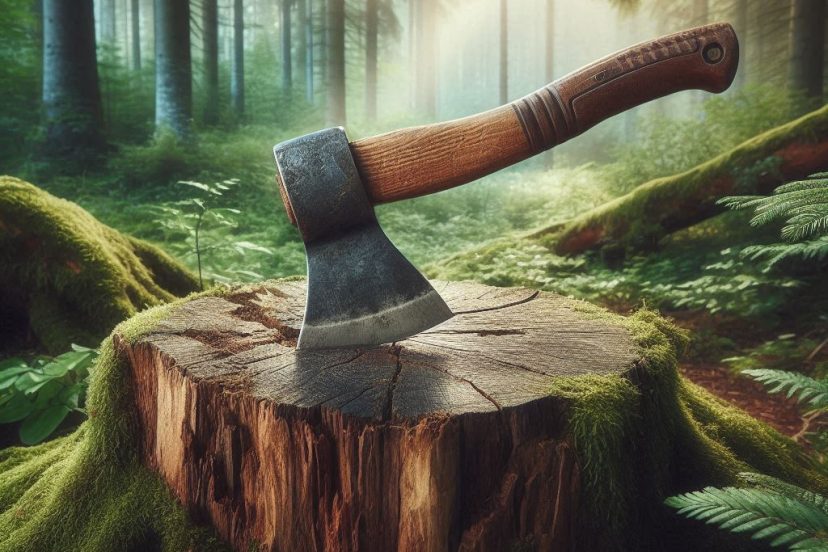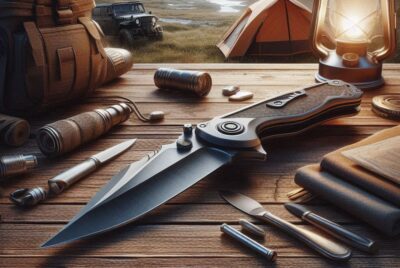Best Camping Hatchet for Outdoor Adventures
*We may earn a commission for purchases made using our links. Please see our disclosure to learn more.
Best Camping Hatchet for Outdoor Adventures and Survival
Camping lets me take a break from my daily routine and enjoy the outdoors. A camping hatchet is an important tool for anyone who wants to cut small branches, split firewood, or make simple repairs at a campsite. The right hatchet can make setting up camp or starting a fire much easier and faster.
A camping hatchet needs to be strong, but not too heavy to carry. I always look at the material of the blade, because high-quality steel stays sharp longer and is safer to use. The handle should feel comfortable with a good grip, even if my hands are wet. Weight and size also matter since the hatchet should fit in my pack but still be large enough for serious jobs.
It can be hard to know what to pick with so many choices available. I spent hours comparing different hatchets, looking at their build, comfort, and cutting power to find the best camping hatchets for most people.
Best Camping Hatchets
I have reviewed the top options to help you find the best camping hatchet for your next trip. Each hatchet on this list is chosen for its quality, ease of use, and value.
Gerber Pack Hatchet
If you need a reliable, compact hatchet for your next camping trip, the Gerber Pack Hatchet is a smart choice because it balances size, performance, and convenience.
Pros
- Very easy to carry and takes up little space
- Handle is comfortable and doesn’t slip, even when wet
- Cuts small branches and kindling well with its sharp blade
Cons
- Not ideal for chopping larger logs or tough wood
- Sheath takes a bit of practice to remove quickly
- Some may prefer a longer handle for added force
I took the Gerber Pack Hatchet out on a weekend camping trip and immediately noticed how light it felt in my hand. It tucked away into my pack with hardly any bulk. The ergonomic handle really helped while chopping small wood for my campfire—no sore spots or blisters after use.
Cutting through branches about two inches thick went smoothly thanks to the sharp, sturdy blade. The full tang design gave me the confidence that it wouldn’t snap under pressure. I liked having the lanyard hole for extra security and the included sheath made it easy to attach right to my belt.
One thing to keep in mind is that this hatchet is best for lighter tasks. It’s not for splitting firewood or working through thick logs. For quick jobs and ease of carry, though, I found it practical and dependable. If you’re looking for an ultra-portable camp axe for small jobs, Gerber Pack Hatchet fits the bill.
Estwing Camper’s Axe 16”
If you want a tough, well-balanced hatchet that feels secure in your hand, this one is absolutely worth considering.
Pros
- One-piece steel build makes it sturdy and reliable
- Shock-absorbing grip really helps reduce hand fatigue
- Sheath with belt loop makes carrying easy
Cons
- A bit heavier than some smaller hatchets
- Handle can feel bulky for small hands
- Needs regular sharpening with heavy use
When I used the Estwing Camper’s Axe out in the woods, the first thing I noticed was how solid it felt. The one-piece steel design gives it great durability, and I never had to worry about it coming loose or breaking while splitting kindling or chopping small branches. The balance was just right for making clean, controlled cuts.
The shock reduction grip kept my hands comfortable, even after lots of swings. This made it much easier to work for longer without feeling sore. Having the nylon sheath attached to my belt meant I could keep the axe handy as I moved around my campsite.
On the downside, the weight is noticeable compared to more compact hatchets. It isn’t too heavy, but after an hour or two, I started to feel it in my arm. I also need to keep an eye on the blade; it lost some sharpness after a weekend of steady use, so I’d recommend bringing a sharpener. Even so, the strong build and comfortable grip make this a dependable tool for any camping trip.
Estwing Fireside Friend 14″ Splitting Hatchet
This hatchet stands out if you need a strong, easy-to-use tool for splitting wood around the campsite or at home.
Pros
- Feels sturdy and well-balanced when splitting wood
- Shock-absorbing grip reduces hand fatigue
- Forged from one piece of steel, so it is very durable
Cons
- Heavier than some camp hatchets
- Handle can get slippery if wet
- Not great for fine, detailed carving tasks
I picked up the Estwing Fireside Friend before my last camping trip and put it to work right away. I was impressed by just how solid it feels, with no sign of loose parts or weak points. The handle’s shock reduction grip actually made a difference, especially after splitting a pile of kindling for the fire—my hands didn’t get sore like with some cheaper hatchets I’ve tried before.
Weight really does set this one apart. It packs quite a punch for splitting small to medium logs with ease, but the extra heft means you might not want to carry it on long hikes. For car camping or backyard use, the extra weight translates to more power, so I didn’t have to swing as hard to get the job done. The grip was comfortable day to day, but I noticed that it can get a bit slippery after a rain shower or if your hands get sweaty.
This hatchet won’t replace a lightweight backpacking axe or a bushcraft knife for finer work. However, for chopping kindling and splitting logs quickly, I found it reliable. The all-steel build gives peace of mind that it can handle tough jobs. If you often need a compact but powerful splitter, I think the Estwing Fireside Friend 14″ Splitting Hatchet is a dependable choice.
DWFKHT 15.7″ Camping Hatchet
Anyone looking for a reliable camping hatchet that handles wood chopping and carving well should consider this one for its balance, sharp edge, and comfort.
Pros
- Very sharp cutting edge right out of the box
- Solid beech wood handle feels comfortable during use
- Comes with a sturdy leather sheath for storage and transport
Cons
- Handle has a shoulder that makes the back less usable
- The axe is a bit heavier than some smaller models
- Convex grind on the blade edge may not suit everyone
When I picked up the DWFKHT hatchet, the first thing I noticed was the quality of the handle. The smooth beech wood felt great in my hand and didn’t give me any wear or blisters, even after chopping firewood for most of the afternoon. The handle’s balance with the blade made it easy to control every swing.
Chopping and splitting wood was straightforward. The sharpness surprised me—slices went through kindling and small logs quickly. I also tried some light carving and was happy with the detail I could get. It didn’t slip or feel awkward, which I appreciated after using all-metal hatchets that tend to jar my hands.
Storage is simple thanks to the included leather sheath. It protected the blade well and fit in my backpack easily. There are a few drawbacks, like the shoulder at the back of the handle, which limits its use as a hammer. The convex edge also may take a little getting used to if you prefer a flat grind. Even so, the hatchet feels durable and gets the job done for camping, chores, and carving.
Helko Werk Germany Rheinland Hatchet
This hatchet is a reliable choice if you want something durable and well-made for regular camping trips.
Pros
- Feels sturdy and well-balanced during use
- Wide blade slices easily through branches and kindling
- Handle is smooth and comfortable for extended work
Cons
- Price is higher than some alternatives
- Handle grain can be inconsistent
- Sheath rivets could be stronger
After taking the Helko Werk Rheinland Hatchet out on my last camping trip, I was impressed by how balanced and effective it felt in my hands. Swinging through smaller branches took very little effort, and kindling was a breeze. I could tell the handcrafted details set it apart from mass-produced options right away.
The American hickory handle feels smooth, with a finish that helped keep my grip steady even when I got tired. The sharp, wide blade stayed keen through a long afternoon splitting wood, and the leather sheath did a decent job protecting the blade after use. I appreciated the included care oil, which gave me peace of mind about rust prevention.
One thing to note is the price—it’s not the cheapest option out there. I also noticed that the grain on my handle could have been better aligned, and the sheath’s rivets seemed like a weak point. Still, I would reach for this hatchet again for most camping needs.
Buying Guide
When I choose a camping hatchet, the first thing I look at is the blade material. A good hatchet usually has a high-carbon steel or stainless steel blade. This helps it stay sharp and last longer.
Weight and Size
I want a hatchet that is light enough to carry but heavy enough to chop wood easily. Most camping hatchets weigh between 1 and 2 pounds. A handle length of about 12 to 16 inches is easy for me to control and doesn’t take up much space in my bag.
Handle Material Comparison
| Handle Type | Pros | Cons |
| Wood | Comfortable grip | Needs upkeep |
| Fiberglass | Durable, strong | Can be costly |
| Rubber/Plastic | Non-slip grip | Less sturdy |
I pay attention to the handle grip. It should feel comfortable in my hand and not slip easily, even when wet.
Another feature I look at is the hatchet’s balance. A well-balanced hatchet is safer and easier to swing.
Many models come with a sheath or cover for the blade. I find this important for safety and protecting my gear.
Before I buy, I always check the hatchet’s intended use. Some are better for chopping wood, while others can split logs or help with survival tasks. I think about what I’ll need most while camping.
Frequently Asked Questions
I look at trusted hatchet brands, key differences between axes and hatchets, and important features for campers. My answers also focus on the Estwing hatchet and what matters most when picking a tool for outdoor use.
1. What are the top-rated hatchets for bushcraft and survival?
I recommend the Gränsfors Bruk Wildlife Hatchet for its sharp blade and strong build. The Hults Bruk Almike is also popular due to its balance and high-quality steel. The Estwing Sportsman’s Axe is easy to maintain and known for its solid, one-piece design.
2. How does camp axe performance compare to a traditional hatchet for camping tasks?
A camp axe has a longer handle, which lets me chop bigger logs and split wood more easily. A hatchet is lighter and better for small branches, cutting kindling, and carrying in my pack. For simple tasks, I find a hatchet easier to control.
3. Which hatchet features are most important for effective wood splitting while camping?
A sharp, wide blade splits wood faster and with less effort. I look for a sturdy handle and balanced weight so I can swing it safely. A good head-to-handle connection is important to prevent accidents.
4. What are the advantages of an Estwing hatchet for outdoor activities?
Estwing hatchets are made from a single piece of steel, making them tough and less likely to break. The rubber grip helps me keep a firm hold, even when it’s wet. I also find that the blade keeps its edge after repeated use.
5. What factors should be considered when choosing a hatchet for both camping and general outdoor use?
I consider weight, balance, handle material, and blade quality. It needs to be light enough to carry but strong enough for chopping wood. I check for a grip that won’t slip and a design that feels safe in my hand.









